What Did Renaissance Artist Try Do With Their Art
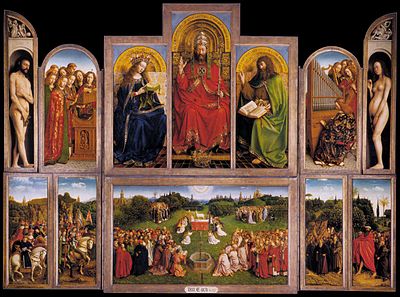
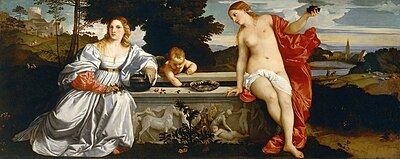
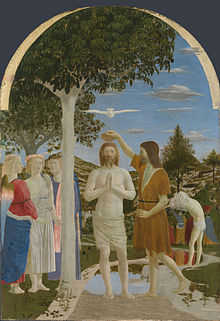
Renaissance fine art (1350 - 1620 AD[1]) is the painting, sculpture, and decorative arts of the flow of European history known as the Renaissance, which emerged as a distinct style in Italy in about Advertising 1400, in parallel with developments which occurred in philosophy, literature, music, science, and technology. Renaissance fine art took equally its foundation the art of Classical antiquity, perceived as the noblest of aboriginal traditions, but transformed that tradition by absorbing contempo developments in the art of Northern Europe and by applying contemporary scientific knowledge. Forth with Renaissance humanist philosophy, it spread throughout Europe, affecting both artists and their patrons with the development of new techniques and new artistic sensibilities. For art historians, Renaissance art marks the transition of Europe from the medieval menstruation to the Early Modern historic period.
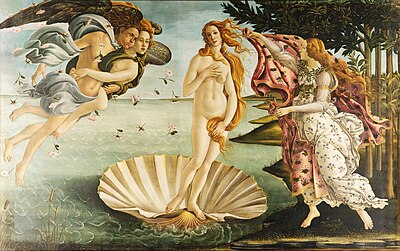
The body of art, painting, sculpture, architecture, music, and literature identified equally "Renaissance art" was primarily produced during the 14th, 15th, and 16th centuries in Europe under the combined influences of an increased awareness of nature, a revival of classical learning, and a more individualistic view of human being. Scholars no longer believe that the Renaissance marked an abrupt suspension with medieval values, as is suggested by the French give-and-take renaissance, literally meaning "rebirth". Rather, historical sources suggest that interest in nature, humanistic learning, and individualism were already present in the late medieval period and became dominant in 15th- and 16th-century Italy, concurrently with social and economic changes such as the secularization of daily life, the rise of a rational money-credit economy, and greatly increased social mobility. In many parts of Europe, Early on Renaissance art was created in parallel with Late Medieval art.
Origins [edit]
Many influences on the development of Renaissance men and women in the early on 15th century accept been credited with the emergence of Renaissance art; they are the same as those that affected philosophy, literature, architecture, theology, science, government and other aspects of society. The following list presents a summary of changes to social and cultural conditions which accept been identified equally factors which contributed to the development of Renaissance art. Each is dealt with more fully in the main articles cited higher up. The scholars of Renaissance period focused on present life and ways to make man life evolve and ameliorate in its entirety. They did not pay much attention to medieval philosophy or religion. During this flow, scholars and humanists like Erasmus, Dante and Petrarch criticized superstitious beliefs and too questioned them. [two] The concept of education too widened its spectrum and focused more on creating 'an ideal man' who would accept a fair understanding of arts, music, verse and literature and would accept the power to appreciate these aspects of life. During this period, there emerged a scientific outlook which helped people question the needless rituals of the church.
- Classical texts, lost to European scholars for centuries, became bachelor. These included documents of philosophy, prose, poetry, drama, scientific discipline, a thesis on the arts, and early Christian theology.
- Europe gained access to avant-garde mathematics, which had its provenance in the works of Islamic scholars.
- The advent of movable type printing in the 15th century meant that ideas could be disseminated easily, and an increasing number of books were written for a broader public.
- The establishment of the Medici Bank and the subsequent merchandise it generated brought unprecedented wealth to a unmarried Italian urban center, Florence.
- Cosimo de' Medici set a new standard for patronage of the arts, not associated with the church or monarchy.
- Humanist philosophy meant that human'south relationship with humanity, the universe and God was no longer the sectional province of the church building.
- A revived interest in the Classics brought about the first archaeological study of Roman remains past the architect Brunelleschi and sculptor Donatello. The revival of a way of architecture based on classical precedents inspired a respective classicism in painting and sculpture, which manifested itself as early on as the 1420s in the paintings of Masaccio and Uccello.
- The comeback of oil paint and developments in oil-painting technique by Belgian artists such as Robert Campin, Jan van Eyck, Rogier van der Weyden and Hugo van der Goes led to its adoption in Italy from well-nigh 1475 and had ultimately lasting furnishings on painting practices worldwide.
- The serendipitous presence within the region of Florence in the early 15th century of certain individuals of artistic genius, well-nigh notably Masaccio, Brunelleschi, Ghiberti, Piero della Francesca, Donatello and Michelozzo formed an ethos out of which sprang the great masters of the High Renaissance, also as supporting and encouraging many lesser artists to accomplish work of extraordinary quality.[three]
- A similar heritage of artistic achievement occurred in Venice through the talented Bellini family unit, their influential in-police force Mantegna, Giorgione, Titian and Tintoretto.[3] [4] [5]
- The publication of two treatises by Leone Battista Alberti, De pictura ("On Painting") in 1435 and De re aedificatoria ("Ten Books on Compages") in 1452.
History [edit]
Proto-Renaissance in Italy, 1280–1400 [edit]

In Italy in the late 13th and early on 14th centuries, the sculpture of Nicola Pisano and his son Giovanni Pisano, working at Pisa, Siena and Pistoia shows markedly classicising tendencies, probably influenced by the familiarity of these artists with ancient Roman sarcophagi. Their masterpieces are the pulpits of the Baptistery and Cathedral of Pisa.
Contemporary with Giovanni Pisano, the Florentine painter Giotto adult a style of figurative painting that was unprecedentedly naturalistic, three-dimensional, lifelike and classicist, when compared with that of his contemporaries and teacher Cimabue. Giotto, whose greatest piece of work is the bike of the Life of Christ at the Arena Chapel in Padua, was seen by the 16th-century biographer Giorgio Vasari as "rescuing and restoring art" from the "rough, traditional, Byzantine way" prevalent in Italy in the 13th century.
Early Renaissance in Italy, 1400–1495 [edit]
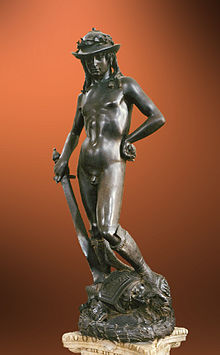
Donatello, David (1440s?) Museo Nazionale del Bargello.
Although both the Pisanos and Giotto had students and followers, the first truly Renaissance artists were not to emerge in Florence until 1401 with the competition to sculpt a set of statuary doors of the Baptistery of Florence Cathedral, which drew entries from seven young sculptors including Brunelleschi, Donatello and the winner, Lorenzo Ghiberti. Brunelleschi, virtually famous as the architect of the dome of Florence Cathedral and the Church building of San Lorenzo, created a number of sculptural works, including a life-sized crucifix in Santa Maria Novella, renowned for its naturalism. His studies of perspective are idea to have influenced the painter Masaccio. Donatello became renowned as the greatest sculptor of the Early Renaissance, his masterpieces beingness his humanist and unusually erotic statue of David, ane of the icons of the Florentine republic, and his nifty monument to Gattamelata, the get-go large equestrian statuary to be created since Roman times.
The contemporary of Donatello, Masaccio, was the painterly descendant of Giotto and began the Early Renaissance in Italian painting in 1425, furthering the tendency towards solidity of form and naturalism of face and gesture that Giotto had begun a century earlier. From 1425–1428, Masaccio completed several console paintings simply is all-time known for the fresco wheel that he began in the Brancacci Chapel with the older artist Masolino and which had profound influence on later on painters, including Michelangelo. Masaccio's developments were carried frontwards in the paintings of Fra Angelico, particularly in his frescos at the Convent of San Marco in Florence.
The handling of the elements of perspective and light in painting was of item concern to 15th-century Florentine painters. Uccello was so obsessed with trying to accomplish an appearance of perspective that, co-ordinate to Giorgio Vasari, it disturbed his sleep. His solutions tin can be seen in his masterpiece set of iii paintings, the Battle of San Romano, which is believed to have been completed by 1460. Piero della Francesca fabricated systematic and scientific studies of both light and linear perspective, the results of which can be seen in his fresco cycle of The History of the True Cantankerous in San Francesco, Arezzo.
In Naples, the painter Antonello da Messina began using oil paints for portraits and religious paintings at a date that preceded other Italian painters, perhaps about 1450. He carried this technique n and influenced the painters of Venice. One of the most significant painters of Northern Italy was Andrea Mantegna, who decorated the interior of a room, the Camera degli Sposi for his patron Ludovico Gonzaga, setting portraits of the family and court into an illusionistic architectural space.
The end catamenia of the Early Renaissance in Italian art is marked, like its beginning, by a item commission that drew artists together, this fourth dimension in cooperation rather than contest. Pope Sixtus IV had rebuilt the Papal Chapel, named the Sistine Chapel in his honour, and deputed a group of artists, Sandro Botticelli, Pietro Perugino, Domenico Ghirlandaio and Cosimo Rosselli to decorate its wall with fresco cycles depicting the Life of Christ and the Life of Moses. In the sixteen large paintings, the artists, although each working in his private style, agreed on principles of format, and utilised the techniques of lighting, linear and atmospheric perspective, anatomy, foreshortening and characterisation that had been carried to a high betoken in the large Florentine studios of Ghiberti, Verrocchio, Ghirlandaio and Perugino.

Early on Netherlandish fine art, 1425–1525 [edit]

The painters of the Low Countries in this period included January van Eyck, his brother Hubert van Eyck, Robert Campin, Hans Memling, Rogier van der Weyden and Hugo van der Goes. Their painting adult partly independently of Early Italian Renaissance painting, and without the influence of a deliberate and witting striving to revive antiquity.
The style of painting grew directly out of medieval painting in tempera, on panels and illuminated manuscripts, and other forms such every bit stained drinking glass; the medium of fresco was less mutual in northern Europe. The medium used was oil paint, which had long been utilised for painting leather ceremonial shields and accoutrements because it was flexible and relatively durable. The earliest Netherlandish oil paintings are meticulous and detailed similar tempera paintings. The material lent itself to the delineation of tonal variations and texture, and so facilitating the observation of nature in bang-up detail.
The Netherlandish painters did not approach the cosmos of a film through a framework of linear perspective and correct proportion. They maintained a medieval view of hierarchical proportion and religious symbolism, while delighting in a realistic treatment of material elements, both natural and homo-made. Jan van Eyck, with his blood brother Hubert, painted The Altarpiece of the Mystical Lamb. It is likely that Antonello da Messina became familiar with Van Eyck's work, while in Naples or Sicily. In 1475, Hugo van der Goes' Portinari Altarpiece arrived in Florence, where it was to have a profound influence on many painters, nearly immediately Domenico Ghirlandaio, who painted an altarpiece imitating its elements.
A very significant Netherlandish painter towards the end of the period was Hieronymus Bosch, who employed the type of fanciful forms that were oftentimes utilized to decorate borders and letters in illuminated manuscripts, combining plant and animal forms with architectonic ones. When taken from the context of the illumination and peopled with humans, these forms give Bosch's paintings a surreal quality which have no parallel in the work of any other Renaissance painter. His masterpiece is the triptych The Garden of Earthly Delights.
Early Renaissance in France, 1375–1528 [edit]

The artists of France (including duchies such as Burgundy) were frequently associated with courts, providing illuminated manuscripts and portraits for the nobility as well as devotional paintings and altarpieces. Among the most famous were the Limbourg brothers, Flemish illuminators and creators of the Très Riches Heures du Duc de Berry manuscript illumination. Jean Fouquet, painter of the majestic courtroom, visited Italian republic in 1437 and reflects the influence of Florentine painters such every bit Paolo Uccello. Although all-time known for his portraits such as that of Charles VII of French republic, Fouquet likewise created illuminations, and is idea to exist the inventor of the portrait miniature.
There were a number of artists at this appointment who painted famed altarpieces, that are stylistically quite distinct from both the Italian and the Flemish. These include 2 enigmatic figures, Enguerrand Quarton, to whom is ascribed the Pieta of Villeneuve-lès-Avignon, and Jean Hey, otherwise known as "the Master of Moulins" afterwards his most famous work, the Moulins Altarpiece. In these works, realism and close observation of the homo figure, emotions and lighting are combined with a medieval formality, which includes gilt backgrounds.
High Renaissance in Italy, 1495–1520 [edit]
The "universal genius" Leonardo da Vinci was to farther perfect the aspects of pictorial fine art (lighting, linear and atmospheric perspective, anatomy, foreshortening and characterisation) that had preoccupied artists of the Early Renaissance, in a lifetime of studying and meticulously recording his observations of the natural world. His adoption of oil paint as his chief media meant that he could depict lite and its furnishings on the landscape and objects more than naturally and with greater dramatic outcome than had ever been done before, as demonstrated in the Mona Lisa (1503–1506). His autopsy of cadavers carried forward the understanding of skeletal and muscular anatomy, as seen in the unfinished Saint Jerome in the Wilderness (c. 1480). His depiction of human emotion in The Last Supper, completed 1495–1498, gear up the criterion for religious painting.
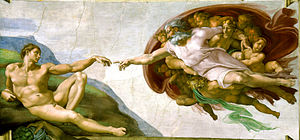
The fine art of Leonardo's younger contemporary Michelangelo took a very unlike direction. Michelangelo in neither his painting nor his sculpture demonstrates any interest in the observation of any natural object except the human body. He perfected his technique in depicting it, while in his early twenties, past the creation of the enormous marble statue of David and the grouping Pietà, in the St Peter'south Basilica, Rome. He so ready virtually an exploration of the expressive possibilities of the human anatomy. His committee by Pope Julius II to paint the Sistine Chapel ceiling resulted in the supreme masterpiece of figurative composition, which was to accept profound upshot on every subsequent generation of European artists.[half-dozen] His later work, The Last Judgement, painted on the chantry wall of the Sistine Chapel betwixt 1534 and 1541, shows a Mannerist (also called Late Renaissance) manner with generally elongated bodies which took over from the Loftier Renaissance style between 1520 and 1530.
Standing aslope Leonardo and Michelangelo as the third great painter of the High Renaissance was the younger Raphael, who in a brusk lifespan painted a great number of life-like and engaging portraits, including those of Pope Julius II and his successor Pope Leo X, and numerous portrayals of the Madonna and Christ Child, including the Sistine Madonna. His death in 1520 at age 37 is considered by many art historians to exist the terminate of the High Renaissance period, although some individual artists continued working in the High Renaissance style for many years thereafter.
In Northern Italy, the Loftier Renaissance is represented primarily by members of the Venetian schoolhouse, especially past the latter works of Giovanni Bellini, specially religious paintings, which include several large altarpieces of a type known as "Sacred Conversation", which testify a group of saints around the enthroned Madonna. His contemporary Giorgione, who died at about the age of 32 in 1510, left a small number of enigmatic works, including The Tempest, the subject of which has remained a matter of speculation. The primeval works of Titian engagement from the era of the High Renaissance, including a massive altarpiece The Assumption of the Virgin which combines human activeness and drama with spectacular colour and atmosphere. Titian continued painting in a generally Loftier Renaissance style until about the cease of his career in the 1570s, although he increasingly used colour and calorie-free over line to define his figures.
High german Renaissance art [edit]

German Renaissance art falls into the broader category of the Renaissance in Northern Europe, also known every bit the Northern Renaissance. Renaissance influences began to appear in High german fine art in the 15th century, but this trend was not widespread. Gardner'due south Art Through the Ages identifies Michael Pacher, a painter and sculptor, equally the first German artist whose piece of work begins to bear witness Italian Renaissance influences. Co-ordinate to that source, Pacher'due south painting, St. Wolfgang Forces the Devil to Hold His Prayerbook (c. 1481), is Tardily Gothic in style, but too shows the influence of the Italian artist Mantegna.[7]
In the 1500s, Renaissance fine art in Germany became more mutual as, co-ordinate to Gardner, "The art of northern Europe during the sixteenth century is characterized by a sudden awareness of the advances made by the Italian Renaissance and by a desire to digest this new style as rapidly as possible."[8] One of the all-time known practitioners of German Renaissance fine art was Albrecht Dürer (1471–1528), whose fascination with classical ideas led him to Italy to study art. Both Gardner and Russell recognized the importance of Dürer's contribution to German art in bringing Italian Renaissance styles and ideas to Frg.[nine] [ten] Russell calls this "Opening the Gothic windows of German language art,"[nine] while Gardner calls information technology Dürer's "life mission."[10] Importantly, as Gardner points out, Dürer "was the first northern artist who fully understood the basic aims of the southern Renaissance,"[ten] although his fashion did not always reflect that. The same source says that Hans Holbein the Younger (1497–1543) successfully alloyed Italian ideas while also keeping "northern traditions of close realism."[11] This is assorted with Dürer's tendency to work in "his own native German style"[ten] instead of combining High german and Italian styles. Other important artists of the German Renaissance were Matthias Grünewald, Albrecht Altdorfer and Lucas Cranach the Elderberry.[12]
Artisans such as engravers became more than concerned with aesthetics rather than just perfecting their crafts. Germany had primary engravers, such every bit Martin Schongauer, who did metal engravings in the late 1400s. Gardner relates this mastery of the graphic arts to advances in press which occurred in Germany, and says that metal engraving began to supplant the woodcut during the Renaissance.[13] However, some artists, such as Albrecht Dürer, continued to do woodcuts. Both Gardner and Russell describe the fine quality of Dürer'due south woodcuts, with Russell stating in The World of Dürer that Dürer "elevated them into loftier works of art."[nine]
Britain [edit]
United kingdom of great britain and northern ireland was very belatedly to develop a distinct Renaissance style and near artists of the Tudor court were imported foreigners, ordinarily from the Low Countries, including Hans Holbein the Younger, who died in England. One exception was the portrait miniature, which artists including Nicholas Hilliard developed into a distinct genre well before information technology became pop in the rest of Europe. Renaissance art in Scotland was similarly dependent on imported artists, and largely restricted to the court.
Themes and symbolism [edit]

Renaissance artists painted a broad variety of themes. Religious altarpieces, fresco cycles, and small works for individual devotion were very popular. For inspiration, painters in both Italia and northern Europe oft turned to Jacobus de Voragine'southward Gold Legend (1260), a highly influential source book for the lives of saints that had already had a strong influence on Medieval artists. The rebirth of classical antiquity and Renaissance humanism also resulted in many mythological and history paintings. Ovidian stories, for example, were very pop. Decorative ornament, often used in painted architectural elements, was especially influenced by classical Roman motifs.
Techniques [edit]
- The use of proportion – The get-go major handling of the painting every bit a window into space appeared in the work of Giotto di Bondone, at the beginning of the 14th century. True linear perspective was formalized later, past Filippo Brunelleschi and Leon Battista Alberti. In addition to giving a more realistic presentation of fine art, it moved Renaissance painters into composing more paintings.
- Foreshortening – The term foreshortening refers to the artistic effect of shortening lines in a cartoon so every bit to create an illusion of depth.
- Sfumato – The term sfumato was coined by Italian Renaissance artist Leonardo da Vinci and refers to a fine art painting technique of blurring or softening of abrupt outlines by subtle and gradual blending of i tone into another through the use of thin glazes to give the illusion of depth or 3-dimensionality. This stems from the Italian word sfumare meaning to evaporate or to fade out. The Latin origin is fumare, to fume.
- Chiaroscuro – The term chiaroscuro refers to the fine art painting modeling upshot of using a strong contrast between calorie-free and dark to give the illusion of depth or iii-dimensionality. This comes from the Italian words meaning calorie-free (chiaro) and nighttime (scuro), a technique which came into broad use in the Baroque period.
Listing of Renaissance artists [edit]
Italia [edit]
- Giotto di Bondone (1267–1337)
- Filippo Brunelleschi (1377–1446)
- Masolino (c. 1383 – c. 1447)
- Donatello (c. 1386 – 1466)
- Pisanello (c. 1395 – c. 1455)
- Fra Angelico (c. 1395 – 1455)
- Paolo Uccello (1397–1475)
- Masaccio (1401–1428)
- Leone Battista Alberti (1404–1472)
- Filippo Lippi (c. 1406 – 1469)
- Domenico Veneziano (c. 1410 – 1461)
- Piero della Francesca (c. 1415 – 1492)
- Andrea del Castagno (c. 1421 – 1457)
- Benozzo Gozzoli (c. 1421 – 1497)
- Alessio Baldovinetti (1425–1499)
- Antonio del Pollaiuolo (1429 - 1498)
- Antonello da Messina (c. 1430 – 1479)
- Giovanni Bellini (c.1430 - 1516)
- Andrea Mantegna (c. 1431 – 1506)
- Andrea del Verrocchio (c. 1435 – 1488)
- Giovanni Santi (1435–1494)
- Carlo Crivelli (c. 1435 – c. 1495)
- Donato Bramante (1444 - 1514)
- Sandro Botticelli (c. 1445 – 1510)
- Luca Signorelli (c. 1445 – 1523)
- Biagio d'Antonio (1446–1516)
- Pietro Perugino (1446–1523)
- Domenico Ghirlandaio (1449–1494)
- Leonardo da Vinci (1452–1519)
- Pinturicchio (1454-1513)
- Filippino Lippi (1457-1504)
- Andrea Solari (1460–1524)
- Piero di Cosimo (1462–1522)
- Vittore Carpaccio (1465-1526)
- Bernardino de' Conti (1465–1525)
- Giorgione (c. 1473 - 1510)
- Michelangelo (1475–1564)
- Lorenzo Lotto (1480 - 1557)
- Raphael (1483–1520)
- Marco Cardisco (c. 1486 – c. 1542)
- Titian (c. 1488/1490 – 1576)
- Corregio (c. 1489 – 1534)
- Pietro Negroni (c. 1505 – c. 1565)
- Sofonisba Anguissola (c. 1532 – 1625)
Low Countries [edit]
- Hubert van Eyck (1366?–1426)
- Robert Campin (c. 1380 – 1444)
- Limbourg brothers (fl. 1385–1416)
- Jan van Eyck (1385?–1440?)
- Rogier van der Weyden (1399/1400–1464)
- Jacques Daret (c. 1404 – c. 1470)
- Petrus Christus (1410/1420–1472)
- Dirk Bouts (1415–1475)
- Hugo van der Goes (c. 1430/1440 – 1482)
- Hans Memling (c. 1430 – 1494)
- Hieronymus Bosch (c. 1450 – 1516)
- Gerard David (c. 1455 – 1523)
- Geertgen tot Sint Jans (c. 1465 – c. 1495)
- Quentin Matsys (1466–1530)
- Jean Bellegambe (c. 1470 – 1535)
- Joachim Patinir (c. 1480 – 1524)
- Adriaen Isenbrant (c. 1490 – 1551)
Deutschland [edit]
- Hans Holbein the Elder (c. 1460 – 1524)
- Matthias Grünewald (c. 1470 – 1528)
- Albrecht Dürer (1471–1528)
- Lucas Cranach the Elder (1472–1553)
- Hans Burgkmair (1473–1531)
- Jerg Ratgeb (c. 1480 – 1526)
- Albrecht Altdorfer (c. 1480 – 1538)
- Leonhard Beck (c. 1480 – 1542)
- Hans Baldung (c. 1480 – 1545)
- Wilhelm Stetter (1487–1552)
- Barthel Bruyn the Elder (1493–1555)
- Ambrosius Holbein (1494–1519)
- Hans Holbein the Younger (c. 1497 – 1543)
- Conrad Faber von Kreuznach (c. 1500 – c. 1553)
- Lucas Cranach the Younger (1515–1586)
French republic [edit]
- Enguerrand Quarton (c. 1410 – c. 1466)
- Barthélemy d'Eyck (c. 1420 – later on 1470)
- Jean Fouquet (1420–1481)
- Simon Marmion (c. 1425 – 1489)
- Nicolas Froment (c. 1435 – c. 1486)
- Jean Hey (fl. c. 1475 – c. 1505)
- Jean Clouet (1480–1541)
- François Clouet (c. 1510 – 1572)
Spain and Portugal [edit]
- Jaume Huguet (1412–1492)
- Nuno Gonçalves (c. 1425 – c. 1491)
- Bartolomé Bermejo (c. 1440 – c. 1501)
- Paolo da San Leocadio (1447 – c. 1520)
- Pedro Berruguete (c. 1450 – 1504)
- Ayne Bru
- Juan de Flandes (c. 1460 – c. 1519)
- Luis de Morales (1512–1586)
- Alonso Sánchez Coello (1531–1588)
- El Greco (1541–1614)
- Grão Vasco (1475-1542)
- Gregório Lopes (1490-1550)
- Francisco de Holanda (1517-1585)
- Cristóvão Lopes (1516-1594)
- Cristóvão de Figueiredo (?-c.1543)
- Jorge Afonso (1470-1540)
- António de Holanda (1480-1571)
- Cristóvão de Morais
Venetian Dalmatia (mod Croatia) [edit]
- Giorgio da Sebenico (c. 1410 – 1475)
- Niccolò di Giovanni Fiorentino (1418–1506)
- Andrea Alessi (1425–1505)
- Francesco Laurana (c. 1430 – 1502)
- Giovanni Dalmata (c. 1440 – c. 1514)
- Nicholas of Ragusa (1460? – 1517)
- Andrea Schiavone (c. 1510/1515 – 1563)
Works [edit]
- Ghent Altarpiece, by Hubert and Jan van Eyck
- The Arnolfini Portrait, by January van Eyck
- The Werl Triptych, past Robert Campin
- The Portinari Triptych, by Hugo van der Goes
- The Descent from the Cross, by Rogier van der Weyden
- Flagellation of Christ, by Piero della Francesca
- Spring, past Sandro Botticelli
- Lamentation of Christ, by Mantegna
- The Last Supper, by Leonardo da Vinci
- The School of Athens, by Raphael
- Sistine Chapel ceiling, past Michelangelo
- Equestrian Portrait of Charles V, by Titian
- Isenheim Altarpiece, by Matthias Grünewald
- Melencolia I, by Albrecht Dürer
- The Ambassadors, past Hans Holbein the Younger
- Melun Diptych, past Jean Fouquet
- Saint Vincent Panels, by Nuno Gonçalves
Major collections [edit]
- National Gallery, London, UK
- Museo del Prado, Madrid, Espana
- Uffizi, Florence, Italy
- Louvre, Paris, France
- National Gallery of Art, Washington, Usa
- Gemäldegalerie, Berlin, Germany
- Rijksmuseum, Amsterdam
- Metropolitan Museum of Fine art, New York City, Us
- Royal Museums of Fine Arts of Belgium, Belgium, Brussels
- Groeningemuseum, Bruges, Belgium
- Sometime St. John's Hospital, Bruges, Kingdom of belgium
- Bargello, Florence, Italia
- Château d'Écouen (National museum of the Renaissance), Écouen, France
- Vatican museums, The holy see
- Pinacoteca di Brera, Milan, Italy
See besides [edit]
- Danube school
- Forlivese school of art
- History of painting
- Mughal fine art
- Oriental carpets in Renaissance painting
- Lives of the Most First-class Painters, Sculptors, and Architects
References [edit]
- ^ "Renaissance". encyclopedia.com. June 18, 2018.
{{cite spider web}}: CS1 maint: url-status (link) - ^ "What were the impacts of Renaissance on art, architecture, scientific discipline?". PreserveArticles.com: Preserving Your Manufactures for Eternity. 2011-09-07. Retrieved 2021-ten-nineteen .
- ^ a b Frederick Hartt, A History of Italian Renaissance Art, (1970)
- ^ Michael Baxandall, Painting and Feel in Fifteenth Century Italy, (1974)
- ^ Margaret Aston, The Fifteenth Century, the Prospect of Europe, (1979)
- ^ https://www.laetitiana.co.uk/2014/07/introduction-to-renaissance-motility.html
- ^ Gardner, Helen; De la Croix, Horst; Tansey, Richard Thou (1975). "The Renaissance in Northern Europe". Art Through the Ages (6th ed.). New York: Harcourt Brace Jovanovich. p. 555. ISBN0-15-503753-six.
- ^ Gardner, Helen; De la Croix, Horst; Tansey, Richard G (1975). "The Renaissance in Northern Europe". Art Through the Ages (6th ed.). New York: Harcourt Brace Jovanovich. pp. 556–557. ISBN0-15-503753-6.
- ^ a b c Russell, Francis (1967). The World of Dürer . Time Life Books, Time Inc. p. 9.
- ^ a b c d Gardner, Helen; De la Croix, Horst; Tansey, Richard G (1975). "The Renaissance in Northern Europe". Art Through the Ages (sixth ed.). New York: Harcourt Brace Jovanovich. pp. 561. ISBN0-15-503753-6.
- ^ Gardner, Helen; De la Croix, Horst; Tansey, Richard G (1975). "The Renaissance in Northern Europe". Art Through the Ages (6th ed.). New York: Harcourt Brace Jovanovich. pp. 564. ISBN0-15-503753-6.
- ^ Gardner, Helen; De la Croix, Horst; Tansey, Richard Thousand (1975). "The Renaissance in Northern Europe". Art Through the Ages (6th ed.). New York: Harcourt Caryatid Jovanovich. pp. 557. ISBN0-fifteen-503753-6.
- ^ Gardner, Helen; De la Croix, Horst; Tansey, Richard G (1975). "The Renaissance in Northern Europe". Art Through the Ages (sixth ed.). New York: Harcourt Brace Jovanovich. pp. 555–556. ISBN0-15-503753-6.
External links [edit]
- The Early Renaissance
- "Limited Freedom", Marica Hall, Berfrois, 2 March 2011.
Source: https://en.wikipedia.org/wiki/Renaissance_art
0 Response to "What Did Renaissance Artist Try Do With Their Art"
Post a Comment